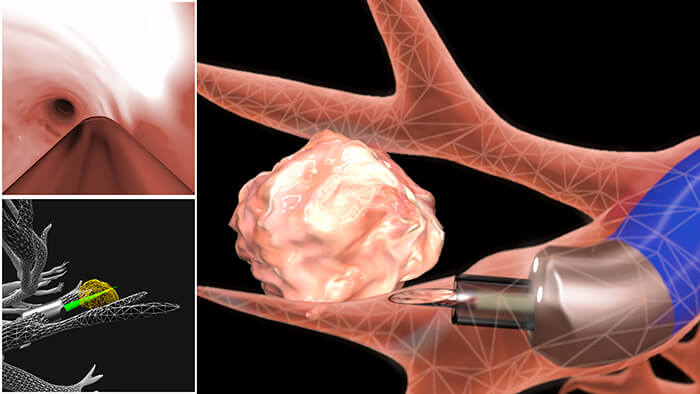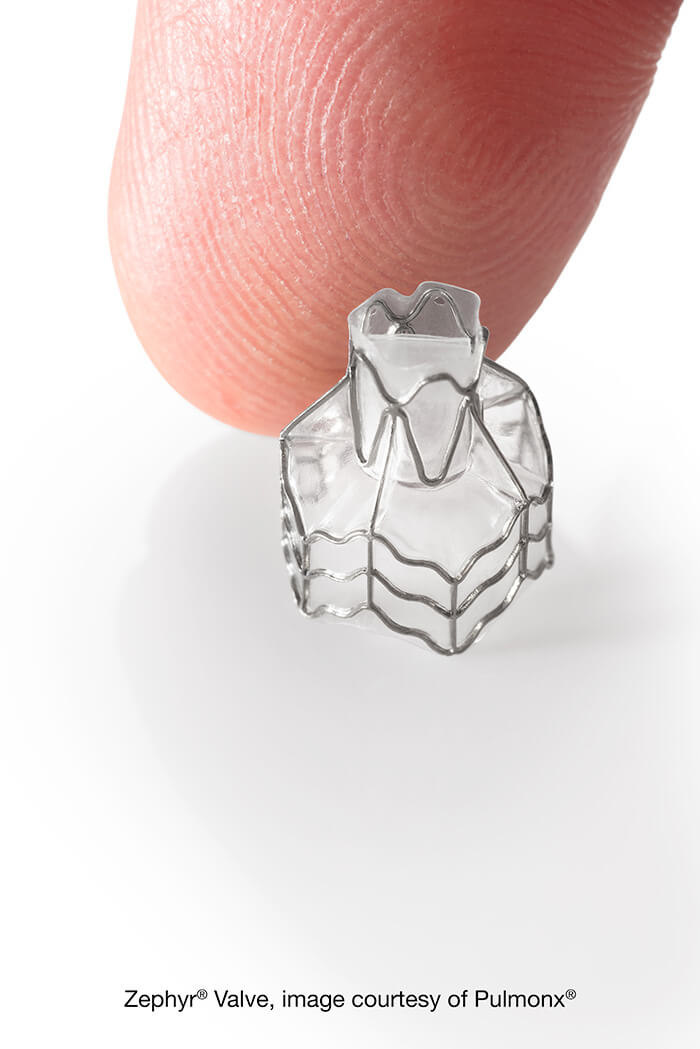Advancing Care with Interventional Bronchoscopy
February 27, 2022
Innovations in Pulmonology & Sleep Medicine | Winter 2022
Patients with suspect peripheral lung nodules and those with severe emphysema have new diagnostic and therapeutic options, thanks to University Hospitals Cleveland Medical Center’s investment in novel clinical techniques.
 Benjamin Young, MD
Benjamin Young, MDMonarch System improves lung cancer diagnosis
Since the advent of low-dose computed tomography screening of patients at high risk for lung cancer, many patients with cancerous lesions are now diagnosed earlier, improving mortality and morbidity. However, taking a biopsy of smaller, hard-to-reach peripheral nodules to make a diagnosis is still challenging.
The Monarch Robotic Bronchoscopy platform allows pulmonologists to access those small nodules in the periphery of the lungs that would otherwise be difficult – or impossible – to reach, says Benjamin Young, MD, Director of Interventional Bronchoscopy at University Hospitals Cleveland Medical Center.
“The Monarch platform allows us to make more accurate diagnoses than prior systems on the market,” Dr. Young says. “The robot gives us precise control of the tip of the bronchoscope and helps us direct biopsy tools to reach lesions we would not have even tried to reach a year ago. We can diagnose potential lung cancer nodules when they are still small, so we can intervene before they have a chance to progress.”
 Monarch Bronchoscopy - Close up view of needle taking biopsy of Nodule.
Monarch Bronchoscopy - Close up view of needle taking biopsy of Nodule.This robotic system is appropriate for anyone who has a small nodule far removed from the center of the lung, especially patients who are not candidates for other biopsy modules, such as surgery, Dr. Young says. It’s a good option for patients who have emphysema or other advanced lung disease and who may have a concern about lung cancer.
“This technique really complements other procedures we have to biopsy larger, more proximal lesions,” he says. “Since we launched the Monarch system in May 2021, we’ve used it with more than 100 patients. The Monarch robotic platform allows us to provide more definitive answers for patients, so we can start appropriate treatment early or provide peace of mind for patients with non-cancerous nodules.”
New option for patients with advanced emphysema
University Hospitals Cleveland Medical Center is also offering a new method of lung volume reduction for patients with severe emphysema.

“These patients have hyperinflation of the lung, so the diseased portion of the lung gets bigger and adversely affects the function of nearby, healthier lung tissue,” Dr. Young says. “This means patients must work harder to breathe, so they become breathless quickly. The Zephyr valve allows us to change their mechanics of breathing.”
For the past 20 to 30 years, clinicians reduced lung volume by surgically removing the damaged portions of the lung. This worked well for some patients, Dr. Young says, but only a very small subset of patients with advanced emphysema were candidates. The pool of candidates for the Zephyr valves is a broader group of patients with emphysema, including those with such severe lung disease that they may also be candidates for lung transplantation.
The Zephyr one-way valve deflates damaged portions of the lung without surgery, blocking off the entryway into that portion of lung so air can exit the lung, but not reinflate, reducing hyperinflation and allowing the healthy portion of the lungs to work more efficiently.
The 4- to 5-millimeter valves are placed via bronchoscopy under anesthesia. The number of valves placed varies, depending on the extent of the patient’s lung disease, but the average is three to four valves.
It may take a couple of months for patients to see the benefits, but with exercise, they can build their strength back, Dr. Young says. To date, University Hospitals Cleveland Medical Center has placed valves in about 15 patients with good results.
“We’ve learned to identify patients who are — or are not — going to respond to this procedure,” Dr. Young says. “We perform a lot of testing beforehand to be sure we’re selecting patients who are going to benefit.
“This is an exciting treatment option,” he adds. “Some of these patients are pretty debilitated. The valves make the work of breathing easier. About 80 percent of patients have meaningful lifestyle improvements.”

For more information about the Monarch platform or Zephyr valves, call Dr. Young at 216-541-1591.
Contributing Expert:
Benjamin Young, MD
Director, Interventional Bronchoscopy
University Hospitals Cleveland Medical Center
Associate Professor of Medicine
Case Western Reserve University School of Medicine


